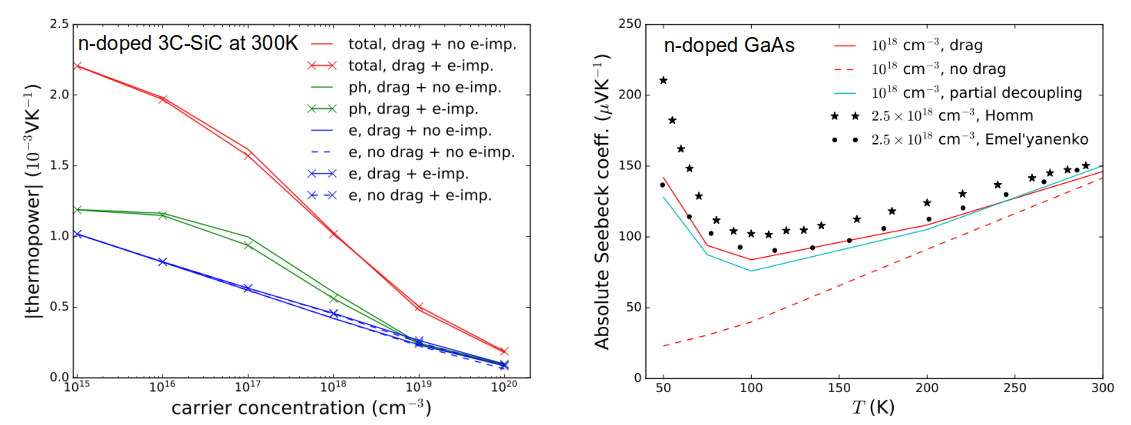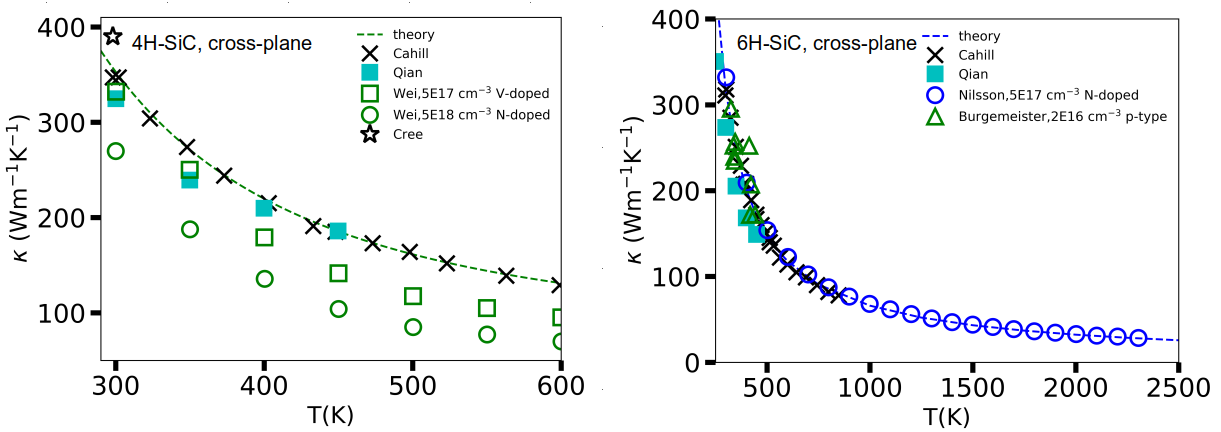Research Highlights
Table of Contents
| Home | Research Highlights | CV | Google Scholar profile |
Mutual drag effect in the interacting electron-phonon gas
“Drag” – the effect of non-equilibrium phonons (electrons) on electron (phonon) transport – requires a self-consistent solution of the transport equations of both the interacting systems. The drag effect can lead to a spectacular increase of the various electron and phonon transport coefficients even at room temperature.
During my PhD at Boston College, I worked with Prof. David Broido to develop a computational scheme for solving the coupled electron and phonon Boltzmann transport equations (BTEs). We combined analytical models of the electron-phonon interactions with ab initio phonon-phonon interaction and showed that the drag effect leads to a signature turning point of the thermpower around \(100\) K in n-doped GaAs, reproducing experimental finding. Afterward, during my postdoctoral work at Harvard University in Prof. Boris Kozinsky's group, I applied the coupled BTEs solver – this time with both the electron-phonon and phonon-phonon interactions calculated ab initio – to n-doped 3C-SiC. We showed that at room temperature:
- the mutual electron-phonon drag effect strongly enhances the mobility and the thermopower;
- the thermopower is immune to the presence of impurities in both the electron and the phonon systems; and
- the drag effect causes strong violation of the Wiedemann-Franz law.

For the details, read:
- Nakib Haider Protik and Boris Kozinsky. Electron-phonon drag enhancement of transport properties from a fully coupled ab initio Boltzmann formalism. Physical Review B 102, 245202. 2020.
- Nakib Haider Protik and David Broido. Coupled transport of phonons and carriers in semiconductors: A case study of n-doped GaAs Physical Review B 101, 075202. 2020.
Phonon transport in hexagonal SiC
The hexagonal (2H, 4H, and 6H) polytypes of SiC are a group of large band gap semiconductors with a variety of industrial applications. At the time this work was carried out, there was little consensus in the literature regarding the thermal conductivity, \(\kappa_{\text{L}}\) and the role of the phonon-electron scattering on phonon transport. We solved this puzzle using ab initio methods and found that:
- in all three polytypes the in-plane \(\kappa_{\text{L}}\) is greater than the cross-plane \(\kappa_{\text{L}}\) over a large temperature range;
- for both in- and cross-plane, the \(\kappa_{\text{L}}\) of 2H-SiC is the highest and that of 6H-SiC is the lowest; and
- contrary to claims in existing literature, the phonon-electron scattering does not lead to the strong suppression of \(\kappa_{\text{L}}\).
Following our publication, multiple recent experiments found excellent agreement with our theoretical predictions.

For the details, read:
- Nakib Haider Protik, Ankita Katre, Lucas Lindsay, Jesús Carrete, Natalio Mingo, David Broido. Phonon thermal transport in 2H, 4H and 6H silicon carbide from first principles. Materials Today Physics 1C, 31-38. 2017.
Effect of impurity scattering on phonon transport

Cubic BAs is a promising semiconducting material with the highest known thermal conductivity, \(\kappa_{\text{L}}\). However, it has been suggested that the presence of As vacancies in the grown crystals might be drastically lowering the \(\kappa_{\text{L}}\). We investigated this claim by carrying out ab initio calculations of the phonon-vacancy scattering cross-sections using both the commonly used perturbative and an infinite-orders T-matrix method and found that:
- vacancies cause large and extended bond distortions around the defect site causing the perturbative method to fail;
- a Green’s function based infinite orders T-matrix approach is required to fully capture the effect of the defect on the phonon system; and
- commonly used semi-empirical model of vacancy breaks down for large mass-ratio compounds such as BAs.
More recently, we calculated the effects of the energetically favorable substitutional defects in BAs samples and found that:
- charged substitutions that resemble the host atom scatter phonons less than the neutral counterpart;
- B(C) and Ge(As) substitutions affect the phonon system the least and allow BAs to retain its ultra-high (~\(1000\) Wm\(^{-1}\) K \(^{-1}\)) \(\kappa_{\text{L}}\) even at high doping concentrations; and
- beyond a threshold doping concentration a Fermi level pinning effect causes noticable change in the \(\kappa_{\text{L}}\).
Read more here:
- Mauro Fava, Nakib Haider Protik, Chunhua Li, Navaneetha Krishnan Ravichandran, Jesús Carrete, Ambroise van Roekeghem, Georg K. H. Madsen, Natalio Mingo, and David Broido. How dopants limit the ultrahigh thermal conductivity of boron arsenide: a first principles study. npj Computational Materials. 2021.
- Nakib Haider Protik, Jesús Carrete, Nebil A. Katcho, Natalio Mingo, and David Broido. Ab initio study of the effect of vacancies on the thermal conductivity of boron arsenide. Physical Review B 94, 045207. 2016.